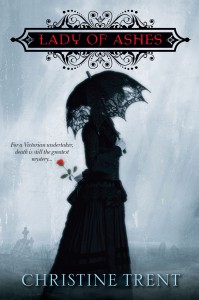4/23/14 WHAT CONNECTS DOLLS, LADY UNDERTAKERS AND NANCY DREW?
 4/23/14 WHAT CONNECTS DOLLS, LADY UNDERTAKERS AND NANCY DREW?
4/23/14 WHAT CONNECTS DOLLS, LADY UNDERTAKERS AND NANCY DREW?
The titles of Christine Trent’s five books of historical fiction will give you some clues about the answer to the Nancy Drew question. The Queen’s Dollmaker, A Royal Likeness, By the King’s Design, Lady of Ashes, and the forthcoming Stolen Remains.
If you guessed there’s a woman with a can-do attitude at the center of these books, you’re right. In a recent interview Christine told me about her heroines and her writing.
SL: Your novels depict strong women who manage successful businesses in spite of civil strife, royal intrigue and laws that favored men. What prepared you to write from this point of view?
CT: I was in a used bookstore in Fredericksburg, Virginia. There was a box of books for one dollar each. One of them was To Dance with Kings by Rosalind Laker. It was thick, it only cost a dollar, and it was a historical romance about a fanmaker for Louis XIV. I fell in love with Rosalind Laker’s writing. Years later when I started to write, I knew I wanted to write about women who were, not swashbuckling, but who were making it on their own.
SL: We don’t think about women in the age of kings making it on their own.
CT: We think of women as staying home and having babies, but it was the high society women who had the freedom to stay home. In the lower and middle classes, women worked alongside their husbands and took over businesses when their husbands died, but not with the same social acknowledgement.
SL: What kind of books did you read when you were young? Did they influence your writing?
CT: I think you have to love reading in order to be a writer. I was the biggest Nancy Drew fan ever. She had great clothes, good friends, and got to solve mysteries. She was not kept down, and no one told her she couldn’t do anything.
SL: Nancy Drew had a big influence on so many of us. Did she influence your writing?
CT: Writing started as a hobby born out of a love of reading. I wanted my historical heroines to be in unusual professions, not the usual dressmaker that readers are familiar with. I wanted something readers might not know about.
SL: Your first book was about a woman who made dolls. What gave you that idea?
CT: I saw something at a museum about dolls. Dollmaking would have been a man’s profession because the dolls were all made of carved wood which was a man’s work. I had read a book about Marie Antoinette and thought I could have a woman in this role of dollmaker. The book became The Queen’s Dollmaker. Later, I heard of a museum in England that claimed to have the doll that Marie Antoinette had in prison with her. It was a confirmation of her attachment to dolls.
SL: Your last book, Lady of Ashes, and Stolen Remains, the one about to be published, are about a lady undertaker. How did you get that idea?
CT: I was at a conference and went to tea with a writer friend who said, “What about a Victorian undertaker?” It was difficult doing the research. At the time, my mom was chronically ill and wanted to make her funeral plans. We were visiting all these funeral homes. After Mom talked to the directors, I talked to them for my research. I will tell you, that was difficult. I was sitting in the car in the parking lot of the funeral home during an earth quake. I thought my writing days were at an end. But I’m still here and my mom is still with us. My publisher liked Lady of Ashes so much, she suggested I make it a series.
SL: Besides talking to funeral directors, how do you research your books?
CT: First I find a profession that readers might find interesting. Then I look for a time-frame when the profession was important and when something interesting was happening, like the industrial revolution and the people who were destroying the machines. Then I look at Google Earth to see what was there in those days. For instance, I was hovering over Regent’s Park in London and learned there was a zoo there in Victorian times. I used that in Lady of Ashes.
SL: Did you come across any information about women involved with undertaking during your research?
CT: I did not run into a woman undertaker. Even today undertaking is a male dominated business, part art, part science. It’s very secretive and methods are passed down in families. I had to piece together the information.
SL: I liked the way your undertaker, Violet, talked to the body and treated it with such respect.
CT: It’s an odd, off-putting subject so I wanted Violet to approach her profession with love. My heroines live in their time, in corsets and dresses. They do not think like men. The women are products of their time.
SL: I read that you have a doll collection. Is there any special doll that inspired your writing in The Queen’s Dollmaker?
CT: Not really. My most special doll isn’t that old. It has no commercial value. It’s a plastic doll, not a baby, but an adult–not Barbie–with a maxi dress that I’ve had since I was six or seven years old. I lost her gold earrings.
SL: Is there anything else you’d like readers to know?
CT: I’ve had readers ask why it takes so long between books. Once the book is written, it’s a long road to publication: editing, editor’s requirements, the publisher selling it to the bookstores. I have a June deadline for a book that comes out next April. I’m writing two books a year now.
SL: That’s a lot of work. How do you manage?
CT: I am disciplining myself. I do a thirty-page outline and write to a recipe.
Sl: Is writing your full-time job?
CT: I used to have another job. I quit my day job in 2011.
Now Christine Trent’s day job is novel writing. Violet, her Lady of Ashes and Stolen Remains heroine, like a Nancy Drew for grown-ups, goes about her Victorian world with great clothes and good friends, solving mysteries that happen to come her way.
Stolen Remains is available now for pre-order. Look for a review here. Find Christine Trent’s books at your local library, at book stores and at Amazon.com.
Sonia Linebaugh
Sonia L. Linebaugh is a freelance writer and artist. Her book At the Feet of Mother Meera: The Lessons of Silence goes straight to the heart of the Westerner’s dilemma: How can we live fully as both spiritual and material beings? Sonia has written three novels and numerous short stories. She’s a past president of Maryland Writers Association, and past editor of MWA’s Pen in Hand. Her recent artist’s book is “Where Did I Think I Was Going?,” a metaphorical journey in evocative images and text.